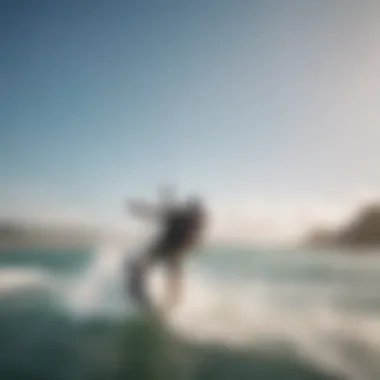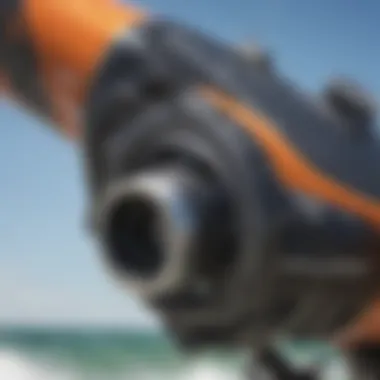Mastering Kitesurfing Pumps: Techniques and Gear


Intro
Kitesurfing is not just a sport; it’s a thrilling blend of power, skill, and the purity of nature. As exhilarating as it may be, understanding the ins and outs of the accompanying gear, particularly the pump, is essential for all kiteboarders, beginners or pros alike. Have you ever thought about how much easier your sessions could be with a good grasp of pumping techniques? This article aims to shed light on the crucial functionality of pumps in kitesurfing, while also exploring the gear that goes hand-in-hand with this beloved water adventure.
Kite pumps come in various shapes and sizes, and each has its strengths. There’s a lot more to these devices than what meets the eye. They aren’t merely tools for inflating your kite; they’re vital instruments that dictate your readiness and, ultimately, your performance on the water. The interplay between efficiency and technique can dramatically enhance your overall kitesurfing experience. Likewise, proper maintenance of gear is of utmost importance to not only boost performance but also extend its life span.
As we glide through this article, we’ll address everything from essential gear to specialized techniques that will sharpen your skills in the water. Whether you're kitesurfing at your local beach or embarking on an adventure in more challenging waters, having a comprehensive understanding of the pump mechanics will elevate your game to a new high.
Intro to Kitesurfing Gear
Kitesurfing, being a sport that marries the thrill of surfing with the power of the wind, demands a specific set of equipment. Each piece of gear plays a vital role in ensuring safety, performance, and enjoyment. Understanding kitesurfing gear is not just about knowing what to buy; it’s about grasping how the right tools can elevate your experience on the water. The synergy between gear and technique often determines a rider’s overall success and satisfaction.
Understanding the Basics
Before diving into the specifics, it's crucial to recognize the foundational elements of kitesurfing gear. At its core, kitesurfing involves a few key components: the kite, the board, and safety equipment. Each item not only plays its own part but also interacts with the others to maximize efficiency on the water.
While learning the ropes, newcomers often face the overwhelming variety of choices available. A more thorough understanding of each component's role can help reduce confusion and aid in making informed decisions. The more you know, the better prepared you’ll be to tackle challenges, whether it be selecting gear or troubleshooting issues.
Key Equipment for Kitesurfing
In kitesurfing, the right gear can be a game changer. Here’s a breakdown of the essential equipment.
Board Types
The various board types significantly influence performance and riding style in kitesurfing. Generally, there are two main categories: twin-tip boards and directional boards. Twin-tip boards are symmetrical, allowing a rider to ride in either direction, making them highly versatile. They are particularly popular among beginners due to their forgiving nature and ease of use.
On the other hand, directional boards, unlike twin-tips, are designed specifically for riding in one direction. They often resemble surfboards and require more skill to manage effectively. However, they can provide advanced sensations and greater speed in waves, making them a preferred choice among experienced riders. In summary, choosing between board types depends on your skill level and the type of kiting you want to pursue.
Kite Varieties
Kites come in various forms, with each designed to cater to specific wind conditions and styles of riding. The most common types are inflatable kites and foil kites. Inflatable kites are by far the most popular, offering stability and ease of relaunching in the water. This makes them a strong option for beginners as they provide added safety in a range of conditions.
Foil kites, while less common, can glide more efficiently and generate lift. These kites are often used in lighter winds, allowing for a different riding experience. Riding with a foil kite demands a higher skill level and an understanding of the nuances of how kites function in varying air conditions. Ultimately, the decision on which kite type to use should reflect your style and the prevalent conditions you expect to encounter.
Wetsuits and Safety Gear
Beyond the kites and boards, wetsuits and safety gear are crucial for a safe and enjoyable experience. Wetsuits provide thermal insulation, which is particularly important in colder waters. They come in various thicknesses and styles, allowing riders to adapt to different water temperatures. For instance, a thicker wetsuit may be necessary during winter, while a thinner suit could be sufficient for summer conditions.
Safety gear, including harnesses, life jackets, and helmets, shouldn't be overlooked. A reliable harness will distribute the kite pull comfortably, enabling you to ride without unnecessary strain. Life jackets buoyancy adds security, especially for beginners still honing their skills in open waters. The right safety gear ultimately helps prevent injuries and makes your sessions more enjoyable.
"Kitesurfing is not just a sport; it's a blend of art and science that requires the right tools and knowledge."
In sum, the right kitesurfing gear forms the basis of enjoyment and confidence in the sport. Choices in boards, kites, and accessories hinge on personal preferences, skill levels, and the conditions you expect to face. Understanding these fundamentals is essential for anyone looking to engage in the exhilarating world of kitesurfing.
What is a Kitesurfing Pump?
Understanding the kitesurfing pump might seem like niche knowledge for some, but its importance cannot be understated. This vital piece of equipment plays a critical role in ensuring that your kite performs optimally. A well-inflated kite enhances both safety and fun, allowing riders to glide smoothly over the water.
A pump, whether manual or electric, is designed to inflate the kite's bladder quickly and efficiently. Proper inflation leads to better lift and responsiveness, which are essential for accomplishing tricks and maneuvers on the water.
Purpose and Functionality
At its core, the primary purpose of a kitesurfing pump is straightforward: it inflates your kite. However, that doesn’t tell the whole story. The functionality extends to ensuring optimal pressure within the kite cells, which directly affects the performance of the kite.
When using a pump, it’s important to understand the optimal pressure that your kite requires. Over-inflating can lead to faults in the kite’s structure, while under-inflation can result in weak lifting power, jeopardizing your experience. Thus, one must always pay attention to the gauge if the pump has one and follow the manufacturer's guidelines.
"A properly pumped kite can make the difference between a thrilling ride and an uncomfortable experience on the water."
Types of Pumps
When it comes to kitesurfing pumps, there are a few distinct types you should familiarize yourself with. Each type serves its purpose, and understanding them can help you make informed choices. Here are three popular varieties:
Single Action Pumps
Single action pumps are pretty much a staple in the kitesurfing world. They inflate on one stroke, which means you push down to pump air into the kite. The key characteristic that sets them apart is their simplicity. With fewer moving parts, they’re generally lighter and easy to manage.
The standout quality of single action pumps is the effective air delivery per stroke for those who prefer a straightforward approach. They are popular mainly because they are compact and easy to transport.
However, there are downsides. You'll find that it takes longer to inflate a kite fully compared to other pump types. Still, many riders appreciate their ease of use, making them perfect for beginners.
Double Action Pumps


Now let’s talk about double action pumps. These are a step up in terms of efficiency. What sets them apart is that they pump air into the kite on both the up and down strokes. This means you can fill your kite faster with less effort.
The major advantage here is speed. A double action pump can get your kite ready for takeoff in no time. However, there's a catch: they can be bulkier, and understanding the pumping rhythm may take a bit of practice.
Still, for those willing to learn, the time saved can make a significant difference, especially in conditions where wind speed is an issue.
Electric Pumps
Electric pumps are really something else. They eliminate manual effort entirely, which can be a lifesaver after a long day of kitesurfing or for those who may struggle with physical limitations.
The distinction here is the convenience factor. Just connect the pump to the kite, set the desired pressure, and let it do its job. Electric pumps are growing in popularity for their consistency in achieving optimal pressure quickly. The downside? They tend to be heavier and can be slightly pricier, not to mention needing a power source.
However, for those who prioritise efficiency over everything else, they can prove invaluable in quickly getting back on the water.
In sum, choosing the right pump is not just about convenience; it diversifies the kitesurfing experience. Beginner or expert, understanding these tools will enhance your ride significantly.
Selecting the Right Pump
Choosing the appropriate pump for kitesurfing is like picking the right paddle for a kayak. A correct pump can greatly affect your overall experience and performance on the water. This section explores the elements to consider when selecting a pump, emphasizing how these factors benefit beginners and experienced riders alike.
Considerations for Beginners
Pump Compatibility with Kites
When getting into kitesurfing, understanding pump compatibility with your kite is crucial. Each kite may have different valve systems that dictate the type of pump you can use. Selecting a pump that fits snugly with your kite's valve ensures efficient inflation and prevents air leaks.
The main characteristic of pump compatibility is its influence on speed and convenience. If your pump aligns well with the kite’s valve, you can inflate faster and spend less time fumbling around trying to make things fit. A beneficial aspect of this compatibility is that it minimizes frustration for newcomers, helping them focus more on enjoying their new sport.
However, it’s essential to recognize that not all pumps work with every kite out there. Some kites might have specialized valves requiring specific pump types. Therefore, checking your kite's specifications and ensuring your pump matches is a unique feature that should not be overlooked. The advantage here is clearer, more straightforward use during your sessions, while the difficulty could arise from narrowing your options down to compatible choices only.
Ease of Use and Storage
For those starting, ease of use and storage is another vital aspect to consider. A pump that’s user-friendly allows beginners to inflate their kites without breaking a sweat. Look out for features like ergonomic handles and simple pumping mechanisms, which make the task feel less cumbersome.
The key characteristic here is convenience. A pump that can easily be handled, transported, and stored saves time and effort. Having a lightweight and compact design is incredibly useful for those who want to hit the beach without dragging a ton of gear behind them. For instance, collapsible pumps that fit in your back pack stand out as a very popular choice among beginners.
However, the trade-off might come in the form of durability; sometimes, too much emphasis on compact and lightweight design might lead to lower-quality materials that wear out faster. So, while ease of use is a significant advantage, ensuring that your pump can hold up over time is equally crucial.
Advanced Options for Experienced Riders
Performance Specifications
When you graduate to more advanced levels, performance specifications become a priority in selecting a pump. Experienced riders want pumps that can deliver higher air pressures and reduce inflation time considerably.
The defining characteristic here is efficiency. Pumps with high-performance specifications can inflate a kite in record time, giving you more time on the water instead of wasting it getting your gear ready. Many riders prefer electric pumps for this very reason since they can achieve the required pressure faster and with less physical effort.
However, a unique feature of these pumps often involves a higher price tag. Though you may fork out more upfront, the investment pays off when you’re out on the water, maximizing performance without burning out your muscles before you even start riding. Thus, understanding performance specifications is vital for advanced riders looking to push their limits.
Durability and Build Quality
For seasoned kitesurfers, durability and build quality are non-negotiable. Riding the waves takes a toll on gear, and a sturdy pump can endure the elements and rough handling. Whether it's intense sunlight, saltwater, or sand, a pump built with materials designed to withstand these factors becomes essential.
The key characteristic that stands out in this context is its long-term reliability. A durable pump means less frequent replacements or repairs, making it a wise investment. You want a pump that, when treated respectfully, stands the test of time.
However, there’s a possible downside; a more robust build often results in a heavier product. This could be a hassle for those who prioritize lightweight gear. Keep in mind that while it may add a bit of weight, the benefits of durability far outweigh the minor inconvenience when you’re out there genuinely enjoying kitesurfing.
The right pump can significantly enhance the kitesurfing experience, allowing more time on the water and less on the beach.
Techniques for Efficient Pumping
When diving into kitesurfing, mastering the pump techniques is crucial. The effectiveness of the pump directly influences your kite's performance on the water. Efficient pumping enhances not only your kite's inflation but also your overall experience on the board. Proper techniques lead to quicker setups, reduced fatigue, and heightened enjoyment, making it imperative for both novices and seasoned kitesurfers to grasp these methods.
Preparing Your Equipment
Laying Out Your Gear
Before you commence the pumping process, laying out your gear demands attention. This stage is about organizing and managing your equipment to create a smooth start. Not only does it minimize confusion, but it also sets the tone for an efficient kitesurfing session. One key characteristic of this phase is the systematic arrangement of your pump, kite, and board. By positioning them close and in an orderly manner, you save precious time and reduce the need to scurry about looking for items.
A notable feature of laying out your gear is its contribution to logistics. For instance, having everything visible allows for quick checks of each component's condition, ensuring you're not headed to the water with a half-inflated kite or a faulty board. Ultimately, this method of preparation plays a significant role in ensuring efficiency – a well-laid out setup leads to less time putting gear together, and more time riding the waves.
Initial Setup Procedures


Following the gear layout, the initial setup procedures come into play. This step encompasses the finer points of attaching the pump to the kite and ensuring all parts are functional. A central feature here is the connection of the pump hose to the kite's inflation valve, which needs to be secure to prevent air leakage. Getting this part right is a beneficial choice as it lays the foundation for a well-inflated kite.
The unique aspect of these procedures includes pre-inflation checks. Performing a quick overview of the kite's bladders and checking the pump for any potential issues can save a lot of heartache later on. If something's amiss at this stage, it can lead to a frustrating start when you could be out enjoying the wind. Completing these initial setup steps correctly contributes immensely to an efficient pumping experience.
Step-by-Step Pumping Guide
Optimal Stance and Motion
When it comes to the actual pumping, having the optimal stance and motion is paramount. The stance you adopt while pumping influences the flow of air into the kite and your own physical comfort during the process. Balancing your weight evenly on both feet creates stability, allowing your pumping motions to become fluid and more powerful. This characteristic of stance is particularly vital for beginners trying to find their rhythm.
The unique feature here is the flow of movement - a smooth up-and-down action provides better efficiency than erratic pumping. By synchronizing your body movement, you can generate a steady airflow into the kite, which is essential for quick inflation. Embracing this technique not only reduces fatigue but also enhances the overall kite performance when you finally hit the water.
Pumping Rhythm and Timing
As you delve deeper into pumping, maintaining a steady rhythm and timing becomes essential. The right tempo guarantees that each stroke is effective, filling the kite with air without exhausting yourself. A key aspect of this concept is understanding that kites require specific pressure levels that can often be achieved with a rhythmic approach.
The nuance of pumping rhythm is fascinating as it allows you to balance speed and efficiency. For instance, going too fast can lead to inconsistent inflation, while being too slow might mean wasting prime wind time. Finding a pace that works for you ensures that you optimize each stroke while keeping your body’s energy intact. In turn, this balance can offer a smoother ride as your kite works harmoniously in the winds ahead.
The right technique means not just quick setup but improved performance on the water. Keep your stance steady, and find your rhythm!
In summary, mastering the techniques for efficient pumping requires a blend of preparation, posture, and rhythm. This trifecta ensures your kitesurfing experience is rewarding and enjoyable from the moment you set your gear out until you’re riding the waves.
Troubleshooting Common Pumping Issues
When it comes to kitesurfing, a properly functioning pump can be the difference between a smooth ride and a frustrating day on the water. Troubleshooting common pumping issues not only helps ensure that your gear operates efficiently, but also enhances overall enjoyment. Understanding what can go wrong with your pump and how to address these issues can keep you one step ahead of problems that might otherwise spoil your kitesurfing experience.
Identifying Air Leakage
Common Causes of Leakage
Air leakage can be a pesky problem that leaves many kitesurfers scratching their heads. One of the most common culprits is improper sealing at the bladder's junctions. Over time, wear and tear can loosen these seals, leading to slow leaks that can go undetected until it’s too late. Another frequent cause includes small punctures, often a by-product of rough handling or collisions with other gear.
One key characteristic of air leakage issues is that they often develop gradually. This means a kitesurfer could pump up their kite, only to find it deflating far too quickly when they hit the water. This aspect makes it imperative to inspect your equipment after every outing. Acknowledging that leakage is an ever-present risk signifies a more conscientious approach to gear maintenance, which is beneficial for both safety and performance.
Additionally, harsh environmental conditions can lead to issues as well. Sun exposure, sand abrasion, or even cold water can pit against your pump or kite material.
Repairing Torn Bladders
If you discover a leak, the first step generally involves inspecting the bladder. The unique feature of torn bladders is that they often don’t reveal themselves until after you’ve begun pumping or during vigorous kitesurfing. The key to success in managing this issue is simple: early detection.
For kitesurfers, being familiar with the repair process is a significant advantage. Using a repair kit can save you from a day ruined by gear failure. Most kits include adhesive patches designed specifically for bladder repair. This becomes essential for maintaining your kite's performance and longevity.
However, repairing torn bladders isn’t a foolproof solution. Depending on the extent of the damage, some bladders may not respond well to patches, requiring complete replacements. It’s crucial to weigh the cost of repairs versus the price of new equipment, ensuring that your kite stays in top shape without breaking the bank.
Overcoming Pumping Fatigue
Efficient Pumping Techniques
Pumping fatigue can hit like a freight train, especially when gearing up for a long day out on the water. Anyone who's had to inflate a kite knows how exhausting it can be, particularly when the pump isn't cooperating. Efficient pumping techniques are designed specifically to counteract this fatigue. They focus on optimizing both positioning and motion.
One such technique is the use of your body weight effectively. By leaning into the pump’s handle during upward strokes, you can let gravity do part of the work. This gives you a better rhythm, ultimately allowing for greater power with less physical strain. Adopting this method can be a game changer, making pumping less daunting.
What makes efficient pumping so appealing is that it can lead to better pressure in the kite, leading to enhanced performance. By investing time in learning how to pump correctly, you not only save energy but also ensure your session is as productive as possible.
Rest and Recovery Tips
Even with efficient techniques mastered, a kitesurfer can still find themselves worn out. This is where rest and recovery tips come into play. Taking short breaks during the pumping process can rejuvenate your body and make it more manageable over a long day on the water. Making sure to hydrate adequately is also key—thirst can sneak up on you when you're focused on gearing up.
Resting in between sessions also serves a dual purpose. It helps prevent injuries that may arise from overexertion while allowing you to reflect on overall technique. For example, if you notice inconsistent pressure in your kite, use that break to reassess your pumping strategy. Investing time into recovery ultimately enhances your performance and safe practices.
In summation, addressing issues like air leakage and pumping fatigue with an informed approach and proper techniques can significantly elevate the kitesurfing experience.
Utilizing these troubleshooting aspects will ensure a smoother, more enjoyable time on the water, so you can focus on the thrill of riding the waves.
Comparing Manual vs. Electric Pumps
When diving into the world of kitesurfing, the type of pump you opt for can greatly influence your experience on the water. Both manual and electric pumps have their merits, but understanding how they stack up against each other is crucial. What makes one better for certain situations than the other? Let’s break this down to see how each pump fits into the kitesurfing gear landscape.
Benefits of Manual Pumps
Portability


Portability is a major feature of manual pumps, making them a preferred choice for many kiteboarders. These pumps are typically lightweight and easy to carry, which serves well when your setup needs to be mobile. Say you’re hiking to a remote beach or juggling other equipment; a manual pump can easily slung over your shoulder without weighing you down.
The simple design of manual pumps often means they can fold down into a compact size. This means less hassle fitting them into your vehicle or storage space. However, carry is a double-edged sword; sometimes, their efficiency can take a backseat when it comes to larger kites that require more effort to inflate. The most significant aspect here is the ability to pump anywhere, anytime, without the worry of battery life or electric connectivity.
Control and Precision
Control and precision are vital in kitesurfing, especially for riders who take their performance seriously. Manual pumps allow users to manage the air pressure inflow, giving kite enthusiasts a customized feel that some electric options can’t match. When inflating a kite, ensuring just the right amount of air is essential, as too much pressure can lead to popping and too little makes for a soggy beginning.
An added bonus with manual pumps is that there's no risk of mechanical failure compared with their electric counterparts. As there are no electrical systems or batteries involved, you can focus on achieving the perfect inflation technique. On the flip side, it can take some serious elbow grease to keep pumping. But for many, that physical process is part of the ritual, creating a deeper connection with the craft.
Advantages of Electric Pumps
Speed and Efficiency
In a world where time is money, electric pumps shine through their speed and efficiency. They can inflate a kite in what feels like the blink of an eye. This is especially beneficial when you're eager to hit the waves without wasting time sweating over a manual pump. Electric options generally guarantee quicker setups, which means you can spend more time enjoying the wind and water rather than toiling away before launching.
Particularly for those hefty kites or when working with multiple setups in a day, the rapid inflation offered by electric pumps can be a game-changer. However, you may sacrifice a bit of touch and feel in terms of pressure management that adept riders might yearn for.
Reduced Physical Strain
Electric pumps also bring the advantage of reducing physical strain. If you've ever experienced the fatigue that can come from manual pumping, you'll appreciate this feature. Pumping without the need to expend significant physical effort is not just a desirable alternative but also a must for some who might be dealing with injuries or fatigue.
The convenience of turning on a pump and letting it do the work means that you can preserve your energy for the actual kitesurfing, which is where the real fun lies. But keep in mind that electric pumps require a source of power, often needing to be charged or plugged in, which can limit where and when you can use them.
"The choice between manual and electric pumps often boils down to personal preference, set up location and immediate needs. Consider what works best for your kitesurf adventure and adapt accordingly."
Ultimately, both manual and electric pumps have distinct advantages, and the best choice lies in weighing your own priorities and the specific needs of your kitesurfing excursions.
Maintenance and Care of Pumps
Taking care of your kitesurfing pump is just as important as maintaining your kite and board. Without a functional pump, your entire kitesurfing experience can go belly up. Routine maintenance and thoughtful care of your pump ensures not just longevity but also reliability when you're itching to hit the water. It’s crystal clear – no one wants to be struggling with equipment failures right before a session. Keeping your pump clean, properly stored, and inspected helps avoid those unfortunate mishaps.
Routine Cleaning Practices
Post-Session Maintenance
After a day on the water, it’s a smart move to give your gear a solid check-up, and that goes for your pump as well. Post-session maintenance consists of cleaning off any sand or salt that could build up and damage the pump’s mechanics over time. For instance, using fresh water and a soft cloth can effectively wipe down the exterior, preventing corrosion. The key characteristic of this practice is that it acts as a shield against wear and tear, making it a fundamental choice in this article.
Unique feature of post-session maintenance lies in its simplicity; just a few minutes of care can save you a hefty sum on repairs down the line. However, if this practice is neglected, you could face more significant issues, such as stuck valves, which may end up ruining your session. So don’t let those weeks of fun turn into headaches. Make it a habit!
Storage Solutions
Once your pump is clean, consider how you store it. Proper storage is another significant aspect of maintenance. It involves finding a dry and shaded spot to protect your pump from the elements. Storing your pump vertically can be beneficial, minimizing any possibility of accidental damage. A major characteristic of sound storage solutions is that they prevent sun damage and physical impact that might occur when gear is haphazardly piled.
A noteworthy aspect of well-thought-out storage is that it extends the life of your equipment. Although it requires some effort, ensuring your pump is stored correctly also enhances its performance. On the flip side, overlooking storage can lead to increased wear and the potential need for early replacements. Better to be safe than sorry, right?
Long-Term Care for Durability
Inspecting for Wear and Tear
Regular inspection of your pump for wear and tear is crucial for maintaining its efficiency. You should keep an eye out for the small things – cracks, frayed hoses, or loose connections. Making these inspections part of your routine allows you to catch issues before they escalate. An effective aspect of inspecting for wear and tear is its proactive nature; catching problems early saves you stress and money long-term.
The best part is that this doesn’t even take much time. Just a quick look over your pump can make a significant difference. However, if overlooked, minor damage might lead to complete pump failure at the most inconvenient time. Just imagine trying to get that kite up while your pump decides it’s had enough.
Replacement Parts and Upgrades
As with any equipment, it’s sometimes necessary to delve into replacements or upgrades. Knowing when to replace parts can keep your pump running smoothly. The opportunity for upgrades might also enhance performance or improve efficiency levels, addressing any issues you’ve encountered. A standout feature of using replacement parts is the customization opportunities they offer, allowing you to tweak your setup based on your kitesurfing style.
This could be especially beneficial for those who regularly hit the water and seek higher performance. While some might hesitate at the cost of upgrades, the long-term benefits often outweigh the initial investment. Still, you have to weigh the pros and cons; is it worth it to hold on to an old pump that regularly drags down your adventure?
"A pro-active maintenance approach not only saves money but enhances your time on the water."
Being diligent in maintenance and care for your pump sets the foundation for an enjoyable kitesurfing experience. Keeping your gear in top shape means more time catching waves rather than troubleshooting issues on the beach.
Ending
The insight into the world of kitesurfing pumps presented in this article serves not only as a guide but as a vital resource for anyone engrossed in the sport. Understanding how a pump operates and the various techniques associated with it can significantly enhance one’s performance on the water.
Recap of Key Takeaways
- Common Types of Pumps: Whether you opt for a manual or electric pump, knowing the distinct types can shape your kitesurfing experience. Each has its perks, and selecting the right tool ensures efficiency.
- Maintenance Matters: Regular care and routine checks prolong the lifespan of your pump. Simple cleaning and inspections are vital—after all, a sturdy pump makes for a smooth session on the waves.
- Techniques Count: Mastery over pumping technique is key. From optimal stance to an established rhythm, these elements bolster your efficiency and stamina.
- Lifelong Learning: Kitesurfing isn’t just a sport; it’s a journey. Embracing new methods or gear enhances your skill set, making every outing a new adventure.
Encouragement for Lifelong Learning in Kitesurfing
Kitesurfing can feel like an endless dance with the winds, where every small adjustment can lead to a better ride. The knowledge surrounding your gear, especially something as crucial as the pump, enriches not only your skills but also your enjoyment of the sport.
In this fast-evolving sport, trends and technology shift quickly. Keep your ear to the ground and engage with fellow kiteboarders in local communities or online forums like reddit.com.
Ultimately, the essence of kitesurfing lies in exploration—of techniques, of equipment, and of self. So, embrace each moment, keep learning, and push your boundaries on that thrill of riding the waves.















